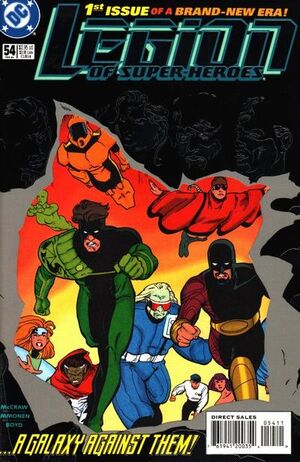With the news that Legion of Super-Heroes will be cancelled, apparently with no plans to continue elsewhere, I've been prompted to once again reread some of my favorite Legion stories, and being the natural critic that I am, I'm reviving
Reviews of Old Comics to chronicle them. Eventually there will be a link in the sidebar to get to these quickly, but for now just click the Tags for more. We're starting with the first one of a long run that I own, so as to not have to go shopping for issues. Also, a couple of these are already reviewed making it easier to get some continuity going.
LEGION OF SUPER-HEROES #298
April 1983
A lot of the things that happen in this issue get brought back for future storylines including one for the end of the Legion's seventh series. There's also a preview of Amethyst, which won't be part of this review but is an excellent addition to this issue as it's a complete, albeit open-ended story awesomely illustrated by Ernie Colon.
SYNOPSIS:
A Legion team is investigating a remote asteroid mine because of reports of trouble. The United Planets consul that contacted them is dead. Seizing the consul'd coffin, Wildfire takes it back to their cruiser where the rest of the team, consisting of Dawnstar, Blok, White Witch and Invisible Kid begin the investigation.
Lightning Lad and Saturn Girl arrive on Medicus One and get the runaround from a receptionist that has trouble understanding their request. They get through to her and visit a physician substituting for regular Legion doctor Gym'll.
Meanwhile, Duplicate Boy, one of the Heroes of Lallor, arrives at Earth seriously mad at Colossal Boy and tracks him to a Himalayan resort where he's enjoying a romantic vacation with Shrinking Violet, which explains Duplicate Boy's anger since last he knew she was
his girlfriend.
Back on the asteroid, White Witch's spell reveals, in a very graphic (to the characters) that the Consul was indeed murdered. Wildfire and Blok go into the mine to investigate.While in the tunnels a loud BOOM nearly causes a collapse which Wildfire helps prevent by leaving his containment suit. Afterwards the miners are very little cooperation in directing to the source of the explosion that nearly collapsed the tunnels, but eventually point the way.
At Legion HQ, Element Lad and Science Police officer Shvaughn Erin receive a call from SP Chief Zendak that Colossal Boy is being attacked in the Himalayas.Ultra Boy, using his prerogative as the new Deputy Leader speeds ahead of the rest of the rescue team to find Duplicate Boy and Colossal Boy slugging it out as giants. He tunnels underground and trips up Duplicate Boy, saving Colossal Boy.
Back on the mining asteroid, Invisible Kid and Dawnstar have joined Wildfire and Blok in their investigation. They discover that behind the explosions and murder is a Khund warrior, Karlak who was disgraced in the challenge courts on Khundia when Legionnaires invaded and used their powers against him. He's upgraded with cybernetics and established a challenge court here in order to get revenge against the Legionnaires. Wildfire goes nuts when he hurts Dawnstar and flies right into having his containment suit blown apartand his energy absorbed. When Blok hurts him, he teleports out. Invisible Kid also vanishes, not just turning invisible, as he remarks he saw something when Wildfire was absorbed by Karlak.
Back in the Himalayas, Duplicate Boy gives up and apologizes for the damage he caused. He loved Shrinking Violet but now realizes that she's "not the Shrinking Violet" he fell in love with. He flies off, and everyone goes back on their way. Shvaughn and Element Lad both recognize that Shrinking Violet had an odd reaction to Duplicate Boy, actually looking afraid.
Elsewhere RJ Brande and his son, Chameleon Boy discuss the Legionnaire losing his powers, similar to how his father lost his from fever, but that Chameleon Boy wants to return to Durla to get his powers back.
REVIEW:
At first glance this is a filler issue, with a lead into an Invisible Kid/Wildfire adventure next issue, but it seems that not too much of importance seems to occur. Paul Levitz in this period was good about juggling subplots and here he is setting up a few storylines that would culminate in the coming months. The big one is the Shrinking Violet story, which came to a head in one of the best comic books I have ever read.
Keith Giffen's art is consistent but hasn't gotten to a peak of its style at this point. He does convey that this is the future and not just space, and this is the period that aliens in Legion stories looked like aliens, and a lot of that credit goes to Keith Giffen, even though he wasn't the first. He does have a little trouble making characters with similar hairstyles look unique.
The colors are ambitious, given that this is a pre-computer time, and Carl Gafford helps illustrate the story, carrying the burden a couple of times to indicate Invisible Kid and convey a sunset in the Himalayas. His variations on the last page are excellent in setting the mood of a gazillionaire's eaborate remote retreat and building to a crescendo of determination.

NOTES:
I don't believe that this issue has been collected anywhere yet, and it may be a little difficult to pick up for a bargain. It isn't going to be too expensive, though, as there are no major events that would spark a frenzy among comic collectors.
FINAL RATING: 7 (out of a possible 10)
The art is good but not fantastic. This issue seems to build up to a lot of bigger things, even without already knowing where the storylines are going. It doesn't seem like enough emotional weight is given to Wildfire's apparent death, even though Blok has a monologue ending the scene. This series would get better, but it was building from the plateau of the Great Darkness Saga












































